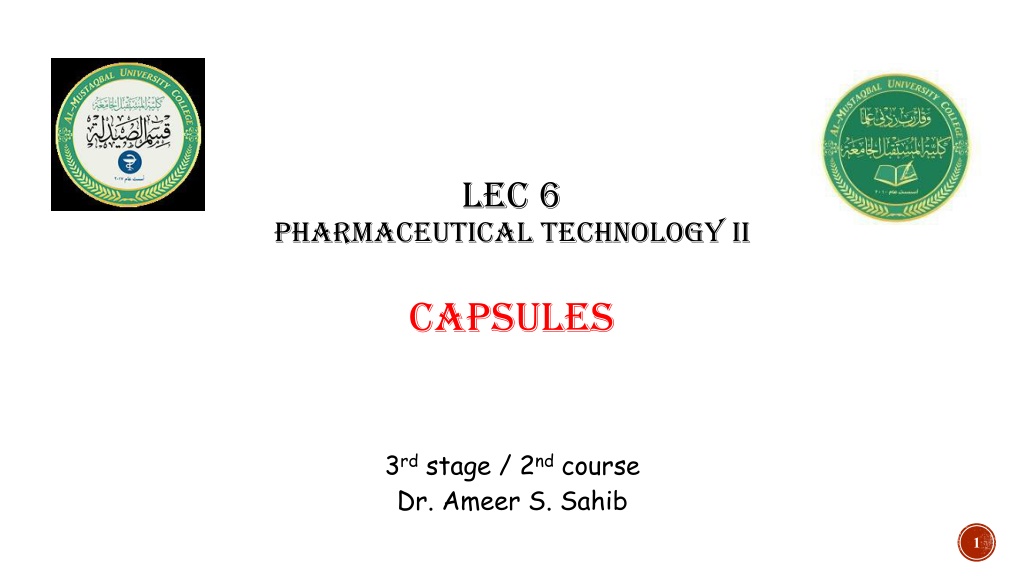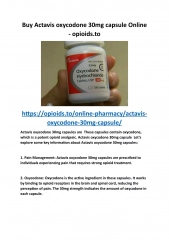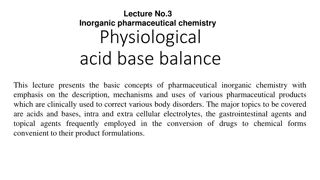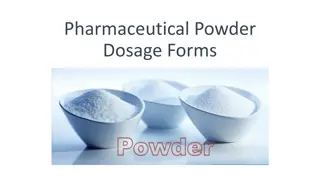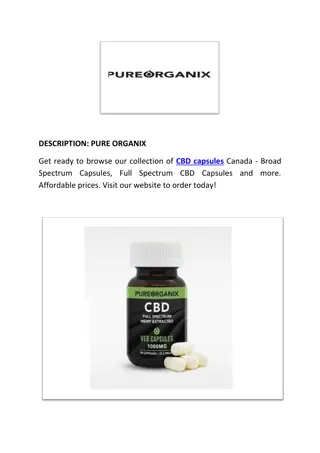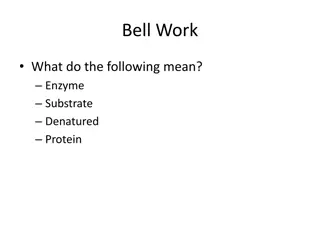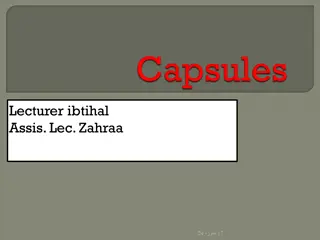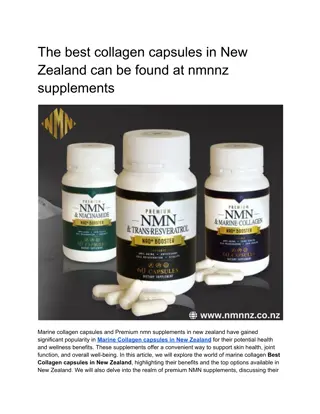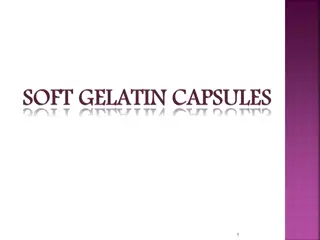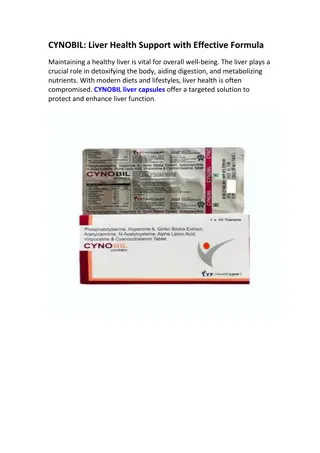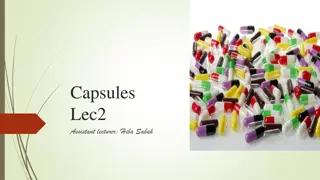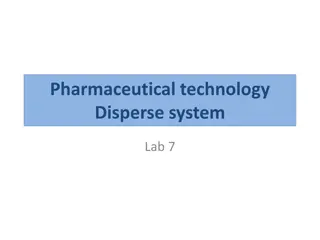The Advantages of Gelatin Capsules in Pharmaceutical Technology
Gelatin capsules are a popular solid dosage form for medicinal agents due to their convenience, stability, and flexibility in dosages. This article explores the composition of gelatin capsules, their advantages, and the effects of moisture on their quality.
Download Presentation

Please find below an Image/Link to download the presentation.
The content on the website is provided AS IS for your information and personal use only. It may not be sold, licensed, or shared on other websites without obtaining consent from the author. Download presentation by click this link. If you encounter any issues during the download, it is possible that the publisher has removed the file from their server.
E N D
Presentation Transcript
lec 6 Pharmaceutical Technology II capsules 3rd stage / 2nd course Dr. Ameer S. Sahib 1
Capsules Capsules are solid dosage form in which medicinal agents and/or inert substances are enclosed in a small shell of gelatin. Gelatin capsule shells may be hard or soft, depending on their composition. 2
Advantages of capsules Elegant and conveniently carried, readily identified, and easily taken. Easily swallowed, so, there is no need for spoons or other measuring devices. It is tasteless and odorless when swallowed They are packaged and shipped by manufacturers at lower cost and with less breakage. It is available for many medications in a variety of dosage strengths, providing flexibility to the prescriber and accurate individualized dosage for the patient. They are also more stable and have a longer shelf life than their liquid counterparts. 3
Hard gelatin capsules Hard gelatin capsule shells are used in most commercial medicated capsules. They are also commonly employed in clinical drug trials to compare the effects of an investigational drug with those of another drug product or placebo. The community pharmacist also uses hard gelatin capsules in the extemporaneous compounding of prescriptions. 4
Hard Gelatin The empty capsule shells are made of gelatin, sugar, and water. As such, they can be clear, colorless, and essentially tasteless. They may be colored with various dyes and made opaque by adding agents such as titanium dioxide (opaquant). Most commercially available medicated capsules contain combinations of colorants and opaquants to make them distinctive, many with caps and bodies of different colors 5
Gelatin Gelatin is obtained by the partial hydrolysis of collagen obtained from the skin, white connective tissue, and bones of animals. It is available in the form of a fine powder, a coarse powder, shreds, flakes, or sheets. Gelatin is stable in air when dry but is subject to microbial decomposition when it becomes moist. Normally, hard gelatin capsules contain 13% to 16% of moisture. However, if stored in an environment of high humidity, additional moisture is absorbed by the capsules, and they may become distorted and lose their rigid shape. In an environment of extreme dryness, some of the moisture normally present in the gelatin capsules is lost, and the capsules may become brittle and crumble when handled. Therefore, it is desirable to maintain hard gelatin capsules in an environment free from excessive humidity or dryness. 6
Effect of moisture on gelatin Because moisture may be absorbed by gelatin capsules and may affect hygroscopic agents within, many capsules are packaged along with a small packet of a desiccant material to protect against the absorption of atmospheric moisture. The desiccant materials most often used are dried silica gel, clay, and activated charcoal. Prolonged exposure to high humidity can affect in- vitro capsule dissolution. Such changes have been observed in capsules containing tetracycline, chloramphenicol, and nitrofurantoin. Because such changes could forewarn of possible changes in bioavailability, capsules subjected to such stress conditions must be evaluated case by case. 7
Gelatin administration Although gelatin is insoluble, it does soften in cold water through the absorption of water up to 10 times its weight of water. Some patients prefer to swallow a capsule wetted with water or saliva because a wetted capsule slides down the throat more readily than a dry capsule. Gelatin is soluble in hot water and in warm gastric fluid; a gelatin capsule rapidly dissolves and exposes its contents. Gelatin, being a protein, is digested by proteolytic enzymes and absorbed. 8
The manufacture of hard gelatin capsule shells Hard gelatin capsule shells are manufactured in two sections, the capsule body and a shorter cap. The two parts overlap when joined, with the cap fitting snugly over the open end of the capsule body. 9
The shells are produced industrially by the mechanical dipping of pins or pegs of the desired shape and diameter into a temperature-controlled reservoir of melted gelatin mixture. The pegs, made of manganese bronze, are affixed to plates, each capable of holding up to about 500 pegs. Each plate is mechanically lowered to the gelatin bath, the pegs submerged to the desired depth and maintained for the desired period to achieve the proper length and thickness of coating. Then the plate and the pegs are slowly lifted from the bath and the gelatin is dried by a gentle flow of temperature- and humidity-controlled air. When dried, each capsule part is trimmed mechanically to the proper length and removed from the pegs, and the capsule bodies and caps are joined together. 10
Capsule shapes A manufacturer also may prepare distinctive-looking capsules by altering the usual rounded shape of the capsule-making pegs. By tapering the end of the body-producing peg while leaving the cap-making peg rounded, one manufacturer prepares capsules differentiated from those of other manufacturers (Pulvules, Eli Lilly) (The Lilly company was founded by Eli Lilly in 1876 to produce medicinal drugs and products). Another manufacturer uses capsules with the ends of both the bodies and caps highly tapered (Spansule Capsules, SmithKline Beecham). 11
Another innovation in capsule shell design is the Snap-fit, Coni-snap and Coni-snap Supro hard gelatin capsules Snap-fit . The original Snap-fit construction enables the two halves of the capsule shells to be positively joined through locking grooves in the shell walls. The two grooves fit into each other and thus ensure reliable closing of the filled capsule. 12
With the high-capacity filling rates of the modern capsule filling machines (more than 180,000 capsules per hour), splitting (telescoping) and/or denting of the capsule shell occur with the slightest contact between the two rims when they are joined. This problem [splitting (telescoping) and/or denting of the capsule shell] which exists primarily with straight-walled capsule shells, led to the development of the Coni-snap capsule, in which the rim of the capsule body is not straight but tapered slightly. This reduces the risk of the capsule rims touching on joining and essentially eliminates the problem of splitting during large-scale filling operations. 13
Coni-snap, and Coni-snap Supro hard gelatin capsules Line drawings of the Coni-snap and Coni-snap supro (right) capsules. The latter is designed to be smaller and to have the lower portion of the capsule shell concealed except for the rounded end. This makes separation of the two parts more difficult and contributes to capsule integrity. 14
In the Coni-snap Supro capsules, the upper capsule part extends so far over the lower part that only the rounded edge of the latter is visible. Opening of such a filled capsule is difficult because the lower surface offers less gripping surface to pull the two halves apart. This increases the security of the contents and the integrity of the capsule. After filling, some manufacturers render their capsules tamper evident through various sealing techniques. 15
Capsule sizes For human use, empty capsules ranging in size from 000 (the largest) to 5 (the smallest) are commercially available Larger capsules are available for veterinary use. For prescriptions requiring extemporaneous compounding, hard gelatin capsules permit a wide number of options for the physician. The pharmacist may compound capsules of a single medicinal agent or combination of agents at the precise dosage prescribed for the individual patient 16
Preparation of filled hard gelatin capsules The large-scale or small-scale preparation of filled hard gelatin capsules is divided into the following general steps. 1. Developing and preparing the formulation and selecting the capsule size 2. Filling the capsule shells 3. Capsule sealing (optional) 4. Cleaning and polishing the filled capsules 17
Developing the capsule formulation In developing a capsule formulation, the goal is to prepare a capsule with; 1. Accurate dosage, 2. Good bioavailability, 3. Ease of filling and production, 4. Stability, and 5. Elegance. 18
Developing the capsule formulation In dry formulations, the active and inactive components must be blended thoroughly to ensure a uniform powder mix for the fill. Care in blending is especially important for low-dose drugs, since lack of homogeneity in blending may result in significant therapeutic consequences. Preformulation studies are performed to determine whether all of the formulation's bulk powders may be effectively blended together as such or require reduction of particle size or any other processing to achieve homogeneity. 19
A diluent or filler may be added to the formulation to produce the proper capsule fill volume. Lactose, microcrystalline cellulose MCC, and starch are commonly used for this purpose. In addition to providing bulk, these materials often provide cohesion to the powders, which is beneficial in the transfer of the powder blend into capsule shells. Disintegrants are frequently included in a capsule formulation to assist the breakup and distribution of the capsule's contents in the stomach. Among the disintegrants used are pregelatinized starch, croscarmellose, and sodium starch glycolate. 20
In preparing capsules on an industrial scale using high-speed automated equipment, the powder mix or granules must be free-flowing to allow steady passage of the capsule fill from the hopper through the encapsulating equipment and into the capsule shells. The addition of a lubricant or glidant such as fumed silicon dioxide, magnesium stearate, calcium stearate, stearic acid, or talc (about 0.25% to 1%) to the powder mix enhances flow properties. When magnesium stearate is used as the lubricant, the waterproofing characteristics of this water-insoluble material can retard penetration by the gastrointestinal fluids and delay drug dissolution and absorption. A surface- active agent, such as sodium lauryl sulfate, is used to facilitate wetting by the gastrointestinal fluids to overcome the problem. 21
To achieve uniform drug distribution, it is advantageous if the density and particle size of the drug and nondrug components are similar. This is particularly important when a drug of low dosage is blended with other drugs or nondrug fill . When necessary, particle size may be reduced by milling to produce particles ranging from about 50 to 1,000 m. Milled powders may be blended effectively for uniform distribution throughout a powder mix when the drug's dosage is 10 mg or greater. For drugs of lower dose or when smaller particles are required, micronization is employed. Depending on the materials and equipment used, micronization produces particles ranging from about 1 to 20 m. 22
Encapsulation of different ingredients 1. Inserting tablets or small capsules into capsules is sometimes useful in the commercial production of capsules and in a pharmacist's extemporaneous preparation of capsules. This may be done to separate chemically incompatible agents or to add premeasured amounts of potent drug substances. Rather than weighing a potent drug, a pharmacist may choose to insert a prefabricated tablet of the desired strength in each capsule. Other less potent agents and diluents may then be weighed and added. 2. On an industrial scale, coated pellets designed for modified-release drug delivery are also commonly placed in capsule shells. Examples of fill in hard gelatin capsules. 1, powder or granulate; 2, pellet mixture; 3, paste; 4, capsule; and 5, tablet 23
Liquid fill Gelatin capsules are unsuitable for aqueous liquids because water softens gelatin and distorts the capsules, resulting in leakage of the contents. However, some liquids, such as fixed or volatile oils, that do not interfere with the stability of the gelatin shells may be placed in locking gelatin capsules (or the capsules may be sealed with a solution of gelatin thinly coating the interface of the cap and body) to ensure retention of the liquid. Rather than placing a liquid as such in a capsule, the liquid may be mixed with an inert powder to make a wet mass or paste, which may then be placed in capsules in the usual manner. Eutectic mixtures of drugs, or mixtures of agents that have a propensity to liquefy when admixed, may be mixed with a diluent or absorbent such as magnesium carbonate, kaolin, or light magnesium oxide to separate the interacting agents and to absorb any liquefied material that may form. In large-scale capsule production, liquids are placed in soft gelatin capsules that are sealed during filling and manufacturing. 24
Extemporaneous compounding of prescriptions 1. Calculate for the preparation of one or two more capsules than required to fill the prescription, to compensate a slight loss of powder 2. Selection of the capsule size. If the dose of the drug is inadequate to fill the volume of the capsule body, a diluent is added. 3. A properly filled capsule should have its body filled with the drug mixture, not the cap. 4. The cap is intended to fit snugly over the body to retain the contents. 25
Capsule size selection In most instances, the amount of drug in a capsule is a single dose. When the usual dose of the drug is too large for a single capsule, two or more capsules may be required, in this case, tells the patient to take two or more capsules instead of one. An easy method to select the proper capsule is to weigh the ingredients for the required number of capsules to be prepared. Place the powders in a graduated cylinder and obtain the volume occupied by the powders. Divide the volume by the number of capsules to be prepared and this provides the volume that will be occupied by the powder for each capsule. Compare this volume (in mls) with the appropriate line of Table 7.1 and select the size that will accommodate the powder. 26
Filling hard capsule shells When filling a small number of capsules in the pharmacy, the pharmacist may use the punch method. The pharmacist takes the precise number of empty capsules to be filled from the stock container. By counting the capsules as the initial step rather than taking a capsule from stock as each one is filled, 1. the pharmacist guards against filling the wrong number of capsules and 2. avoids contaminating the stock container with drug powder. The powder to be encapsulated is placed on a sheet of clean paper or on a glass or porcelain plate. Using the spatula, the powder mix is formed into a cake having a depth of approximately one-fourth to one-third the length of the capsule body. Then an empty capsule body is held between the thumb and forefinger and punched vertically into the powder cake repeatedly until filled. Some pharmacists wear surgical gloves or latex finger cots to avoid handling the capsules with bare fingers. Because the amount of powder packed into a capsule depends on the degree of compression, the pharmacist should punch each capsule in the same manner and weigh the product after capping. 27
Filling of capsules When non-potent materials are placed in capsules, the first filled capsule should be weighed (using an empty capsule of the same size on the opposite balance pan to counter the weight of the shell) to determine the capsule size to use and the degree of compaction to be used. After this determination, the other capsules should be prepared and weighed periodically to check the uniformity of the process. When potent drugs are being used, each capsule should be weighed after filling to ensure accuracy. Such weighings protect against uneven filling of capsules and premature exhaustion or underuse of the powder. After the body of a capsule has been filled and the cap placed on the body, the body may be squeezed or tapped gently to distribute some powder to the cap end to give the capsule a full appearance. Granular material that does not lend itself to the punch method of filling capsules may be poured into each capsule from the powder paper on which it is weighed. 28
Filling of capsules by hand-operating filling machine Pharmacists who prepare capsules on a regular or extensive basis may use a hand-operated filling machine. The various types of machines have capacities ranging from 24 to 300 capsules. The Feton capsule-filling machine A. With empty capsules in the loader tray, the tray placed on top of the filler unit. B. The loader inserts the capsules into the filling unit and is removed, and the top plate is lifted to separate the caps from the bodies. C. The powder is placed on the unit and the capsule bodies are filled. D. The top plate is returned to the unit and the caps are placed on filled capsule bodies. 29
Filling of capsules in large scale Machines developed for industrial use automatically (https://youtu.be/sXFgxDugkb0) and (https://youtu.be/4FfhSWE8i0o). 1- separate the caps from empty capsules, 2- fill the bodies, 3- scrape off the excess powder, 4- replace the caps, 5- seal the capsules as desired, 6- clean the outside of the filled capsules at up to 165,000 capsules per hour. 30
Capsule sealing Some manufacturers make tamper-evident capsules by sealing the joint between the two capsule parts. One manufacturer makes distinctive-looking capsules by sealing them with a colored band of gelatin (Kapseals, Parke-Davis). If removed, the band cannot be restored without expert resealing with gelatin. Capsules may also be sealed through a heat-welding process that fuses the capsule cap to the body through the double wall thickness at their juncture . The process results in a distinctive ring around the capsule where heat welded. Still another process uses a liquid wetting agent that lowers the melting point in the contact areas of the capsule's cap and body and then thermally bonds the two parts using low temperatures (40 C-45 C). Industrial capsule sealing machines are capable of producing 60,000 to 150,000 gelatin-banded, heat-welded, or thermally coupled capsules per hour 31
Capsule identification Capsules and tablets also may be imprinted with the names or monograms of the manufacturer, the assigned national drug code number, and other markings making the product identifiable and distinguishable from other products (https://youtu.be/VuPBOy0POkE). 32
Cleaning and polishing capsules Small amounts of powder may adhere to the outside of capsules after filling. The powder may be bitter or otherwise unpalatable and should be removed before packaging or dispensing. On a small scale, capsules may be cleaned individually or in small numbers by rubbing them with a clean gauze or cloth. On a large scale, many capsule-filling machines are affixed with a cleaning vacuum that removes any extraneous material from the capsules as they exit the equipment, using the Accela-Cota apparatus (https://youtu.be/SXEduweiViw). 33
Soft gelatin capsules Soft gelatin capsules are made of gelatin to which glycerin or a polyhydric alcohol such as sorbitol has been added as plasticizers (plastic property). Soft gelatin capsules, which contain more moisture than hard capsules, may have a preservative, such as methylparaben and/or propylparaben to retard microbial growth. Soft gelatin capsules may be oblong, oval, or round. They may be single colored or two-toned and may be imprinted with identifying markings. As with hard gelatin capsules, they may be prepared with opaquants to reduce transparency and render characteristic features to the capsule shell. Soft gelatin capsules are used to encapsulate and hermetically seal liquids, suspensions, pasty materials, dry powders, and even preformed tablets. Soft gelatin capsules are pharmaceutically elegant and are easily swallowed. 34
Preparation of soft gelatin capsules Soft gelatin capsules may be prepared by the plate process, using a set of molds to form the capsules, or by the more efficient and productive rotary or reciprocating die processes by which they are produced, filled, and sealed in a continuous operation. A - Plate Process By the plate process, a warm sheet of plain or colored gelatin is placed on the bottom plate of the mold and the medication-containing liquid is evenly poured on it. Then a second sheet of gelatin is carefully placed on top of the medication and the top plate of the mold is put into place. Pressure is then applied to the mold to form, fill, and seal the capsules simultaneously. The capsules are removed and washed with a solvent harmless to the capsules. 35
B- Rotatory Die Process By this method, liquid gelatin flowing from an overhead tank is formed into two continuous ribbons by the rotary die machine and brought together between twin rotating dies (https://youtu.be/vs8SK9RL9gs). At the same time, metered fill material is injected between the ribbons precisely at the moment that the dies form pockets of the gelatin ribbons. These pockets of fill- containing gelatin are sealed by pressure and heat and then severed from the ribbon. Use of ribbons of two different colors results in bicolored capsules. The reciprocating die process is similar to the rotary process in that ribbons of gelatin are formed and used to encapsulate the fill, but it differs in the actual encapsulating process. The gelatin ribbons are fed between a set of vertical dies that continually open and close to form rows of pockets in the gelatin ribbons. These pockets are filled with the medication and are sealed, shaped, and cut out of the film as they progress through the machinery. As the capsules are cut from the ribbons, they fall into refrigerated tanks that prevent the capsules from adhering to one another. 36
Use of soft gelatin capsules Soft gelatin capsules are prepared to contain a variety of liquid, paste, and dry fills. Liquids that may be encapsulated into soft gelatin capsules include the following 1. Water-immiscible volatile and nonvolatile liquids such as vegetable and aromatic oils, aromatic and aliphatic hydrocarbons, chlorinated hydrocarbons, ethers, esters, alcohols, and organic acids. 2. Water-miscible nonvolatile liquids, such as polyethylene glycols, and nonionic surface active agents, such as polysorbate 80. 3. Water-miscible and relatively nonvolatile compounds such as propylene glycol and isopropyl alcohol, depending on factors such as concentration used and packaging conditions. 4. Drugs may be encapsulated into soft gelatin capsules as solutions in a suitable liquid solvent, suspensions, dry powders, granules, pellets, or small tablets. 37
Soft gelatin capsule contents contraindication Liquids that can easily migrate through the capsule shell are not suitable for soft gelatin capsules. These materials include water above 5% low-molecular-weight water-soluble and volatile organic compounds such as alcohols, ketones, acids, amines, and esters. Compendial requirements for capsules added substances Substances added to official preparations, including capsules, to enhance their stability, usefulness, or elegance or to facilitate their manufacture may be used only if they 1. Are harmless in the quantities used 2. Do not exceed the minimum amounts required to provide their intended effect 3. Do not impair the product's bioavailability, therapeutic efficacy, or safety 4. Do not interfere with requisite compendial assays and tests 38
Enteric coated capsules Capsules that have been coated or otherwise treated to resist dissolution in gastric fluids but release their contents in the intestine are said to be enteric. Such delayed release of medication may be desired if the drug is inactivated in gastric fluids or if the drug is irritating to the gastric mucosa. In other instances, a high local concentration of the drug may be especially desirable in the intestine, as in the case of anthelmentices. Typical of materials used for enteric coating are shellac, cellulose acetate phthalate, and fatty waxy materials such as bees wax, carnauba wax and stearic acid. One approach for rendering gelatin capsules enteric that has met with only limited success is treatment with formaldehyde. The gelatin is hardened as the formaldehyde reacts with the gelatin to form methylene bridges and cross links. 39
Counting capsules In the pharmacy, capsules may be counted manually or by automated equipment. Specially designed trays (for small scale) are used for counting small numbers of solid dosage units. In using this tray, the pharmacist pours a supply of capsules or tablets from the bulk source onto the clean tray . Using the spatula, counts and sweeps the dosage units into the trough until the desired number is reached. Then the pharmacist closes the trough cover, picks up the tray, returns the uncounted dosage units to the bulk container by means of the lip at the back of the tray. Places the prescription container at the opening of the trough, and carefully transfers the capsules or tablets into the container. With this method, the dosage units remain untouched by the pharmacist. To prevent batch-to-batch contamination, the tray must be wiped clean after each use because powder, particularly from uncoated tablets, may remain 40
Storage of capsules Capsules should be stored in tightly closed containers protected from dust and extremes of humidity and temperature. Capsules normally contain from 10 to 15% of moisture. However, when, stored under conditions of high humidity, sufficient moisture may be absorbed to soften the gelatin and make it tacky. On the other hand, when stored under conditions of low humidity, the capsules may dehydrate and become brittle. 41
